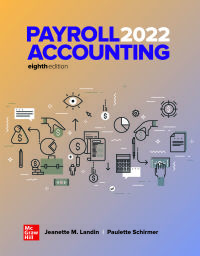Answered step by step
Verified Expert Solution
Question
1 Approved Answer
Check my work 9 Mr. and Mrs. Lovejoy are married filing jointly, with no dependent children. Mr. Lovejoy worked for Smart Tech Corporation January through



Check my work 9 Mr. and Mrs. Lovejoy are married filing jointly, with no dependent children. Mr. Lovejoy worked for Smart Tech Corporation January through March and for Computer Associates the remainder of the year. Mrs. Lovejoy finished her degree in November and immediately began as an associate with Smith and Weber. They report the following information for 2021. Use Individual Tax Rate Schedules and Standard Deduction Table. .12 oints Mr. Lovejoy's salary from Smart Tech Mr. Lovejoy's salary from Computer Associates Mrs. Lovejoy's salary from Smith and Weber Interest from savings account Itemized deductions Dividends eligible for 15% rate $ 32,000 142,000 15,550 700 9,000 2,200 eBook Print References Required: a. Compute AGI. b. Compute taxable income. C. Compute net tax liability (after credits). Complete this question by entering your answers in the tabs below. Required A Required B Required C Compute net tax liability (after credits). (Round your intermediate calculations and final answer to the nearest whole dollar amount.) Tax liability $ 28,160 U Married filing jointly and surviving spouses Married filing separately Head of household Single $25,100 12,550 18,800 12,550 Married Filing Jointly and Surviving Spouse If taxable income is Not over $19,900 Over $19,900 but not over $81,050 Over $81,050 but not over $172,750 Over $172,750 but not over $329,850 Over $329,850 but not over $418,850 Over $418,850 but not over $628,300 Over $628,300 The tax is 10% of taxable income $1,990.00 + 12% of excess over $19,900 $9,328.00 + 22% of excess over $81,050 $29,502.00 + 24% of excess over $172,750 $67,206.00 + 32% of excess over $329,850 $95,686.00 + 35% of excess over $418,850 $168,993.50 + 37% of excess over $628,300 Married Filing Separately If taxable income is Not over $9,950 Over $9,950 but not over $40,525 Over $40,525 but not over $86,375 Over $86,375 but not over $164,925 Over $164,925 but not over $209,425 Over $209,425 but not over $314,150 Over $314,150 The tax is 10% of taxable income $995.00 + 12% of excess over $9,950 $4,664.00 + 22% of excess over $40,525 $14,751.00 +24% of excess over $86,375 $33,603.00 + 32% of excess over $164,925 $47,843.00 + 35% of excess over $209,425 $84,496.75 + 37% of excess over $314,150 Head of Household If taxable income is Not over $14,200 Over $14,200 but not over $54,200 Over $54,200 but not over $86,350 Over $86,350 but not over $164,900 Over $164,900 but not over $209,400 Over $209,400 but not over $523,600 The tax is 10% of taxable income $1,420.00 + 12% of excess over $14,200 $6,220.00 + 22% of excess over $54,200 $13,293.00 + 24% of excess over $86,350 $32,145.00 + 32% of excess over $164,900 $46,385.00 + 35% of excess over $209,400
Step by Step Solution
There are 3 Steps involved in it
Step: 1

Get Instant Access to Expert-Tailored Solutions
See step-by-step solutions with expert insights and AI powered tools for academic success
Step: 2

Step: 3

Ace Your Homework with AI
Get the answers you need in no time with our AI-driven, step-by-step assistance
Get Started


